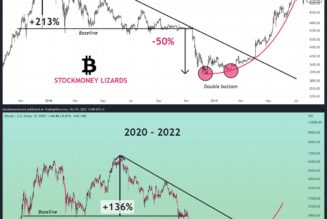The monthly deficit in U.S. goods trade with all other countries set a record high in August at more than $83 billion.
Trump has blamed the trade deficit on bad trade deals negotiated by his predecessors and unfair trade practices by other countries, but most economists disagree with that explanation.
“We have almost an $800 billion a year trade deficit with other nations,” Trump said in November 2017, after returning from his first trip to Asia as president. “Unacceptable. We are going to start whittling that down and as fast as possible.”
In those 2017 comments, Trump seemed to be referring to just the goods trade deficit while ignoring the surplus the U.S. enjoys in services trade. The combined goods and services deficit in 2017 was $514 billion, reflecting a nearly $800 billion goods deficit as well as a $286 billion services surplus. This year, the goods trade deficit is likely to exceed $850 billion.
The trade deficit measures the difference between what the U.S. imports and exports. The powerful U.S. economy sucks up goods from around the world, resulting in an annual trade deficit that has grown dramatically from a mere $6 billion in 1975.
A variety of factors contributed to Trump’s failure to eliminate the trade gap, which White House trade adviser Peter Navarro predicted in 2016 could be erased in one or two years.
Overall trade remains depressed compared to year-ago levels because of the coronavirus pandemic.
But the massive U.S. government stimulus payments to businesses and consumers have helped U.S. imports recover faster than U.S. exports. That explains why the monthly goods deficit has increased from the average level of $73.3 billion in 2019.
However, even without the pandemic, Trump’s practice of piling tariffs on China and selected other products like steel and aluminum was never going to turn around the deficit, most economists agree.
“Short-term fixes like tariffs don’t work,” said Mary Lovely, a senior fellow at the Peterson Institute for International Economics and professor of economics at Syracuse University. “It’s magical thinking.”
The large U.S. trade deficit is fundamentally driven by larger economic factors — like the fact Americans spend more than they save and have to borrow from abroad to finance the difference, Lovely said.
Trump’s $1.5 trillion tax cut in 2017 contributed to that problem by running up the U.S. budget deficit. This year, Congress has approved more than $3 trillion in additional spending to help the U.S. economy recover from the coronavirus pandemic, tripling the budget deficit to $3.3 trillion and pulling the trade deficit along, she said.
U.S. Trade Representative Robert Lighthizer, in a statement on Tuesday, defended the administration’s trade actions and attributed this year’s rise in the deficit to the strength of the U.S. recovery from the pandemic and investors buying gold as a hedge against the crisis.
“In spite of the pandemic, our goods deficit is down 2.4 percent year-to-date,” Lighthizer said. “The goods deficit would have decreased by at least 6 percent but for a large spike in gold imports reflecting risk-hedging strategies during the pandemic, not underlying economics.”
He said a 19-percent fall so far this year in the U.S. services surplus due largely to reduced tourism, travel and transport also helped widen the overall deficit. “As other countries recover and reopen, we expect both imports and exports to improve substantially,” Lighthizer said.
Still, although Trump failed to reduce the overall trade deficit, his tariffs helped change the composition of the deficit, which is important, said Michael Stumo, chief executive of the Coalition for a Prosperous America, a Trump-friendly trade group.
Looking at trade in 2019, the last full year of data, the overall U.S. trade deficit fell by less than 1 percent from the previous year to $577 billion. However, the bilateral trade deficit with China fell by a much more impressive 17 percent to $345 billion as importers turned to other countries such as Mexico, Vietnam, Taiwan, South Korea, Japan and members of the EU.
Imports also supplied a slightly smaller share of U.S. demand for manufactured goods in 2019 as measured by CPA’s “reshoring index” which fell to 30.6 percent, from 31.2 percent in 2018.
That may seem like a tiny change, but the U.S. consumed about $7.1 trillion worth of manufactured goods in 2019. So even a small increase in the U.S. share of that market can help create thousands of new jobs, Stumo said.
But for Trump to fundamentally reduce the trade deficit, he needed to address misaligned currency rates because the strong dollar makes it hard for U.S. exporters to compete against other suppliers, Stumo said.
On that front, he ran into opposition from Wall Street money houses, who fear any aggressive moves to deal with currency because it hurts their bottom line, he said.
“A huge, excessively high part of our economy is finance and they’ll fight it,” Stumo said. “We’d like finance to be strong, but just not that big a part of our economy. We need a little bit more goods production.”
Trump’s “phase one” trade deal with China does contain a chapter which, for the first time in any trade agreement, contains enforceable rules against currency manipulation. While some trade experts worry that could open the door for renewed U.S. trade actions against China, others see the pact as more of a fig leaf.
“We would say one of the big failures of the Trump administration with respect to trade policy is the failure to address currency misalignment in any kind of meaningful way,” said Thea Lee, president of the Economic Policy Institute, a left-leaning think tank aligned with union groups. “Putting a couple of sentences into the deal, but without a clear road map as to how it’s going to be instrumentalized, doesn’t really do very much.”
Lee also faults Trump for failing to pass a huge new infrastructure bill to create more jobs in the United States, as he promised during his 2016 campaign, and for approving a set of tax reforms “that took us in exactly the wrong direction by incentivizing and accelerating offshoring.”
Trump’s revised NAFTA agreement with Mexico and Canada does include strong protections for workers rights, which helped the pact win overwhelming approval in the Democratic-controlled House. But the fact that labor concerns were not addressed in the China agreement “just shows that the Trump administration is not driven by any principles in this area, but simply by political expediency,” Lee said.
The administration hails China’s agreement as part of the phase one trade deal to purchase $200 billion more of U.S. goods and services in 2020 and 2021, compared with the record it set in 2017.
But the data released on Tuesday shows that China is well behind on that goal. During the first eight months of this year, it had imported just $69.5 billion worth of U.S. farm and manufactured goods, compared to $80.2 billion in the same period in 2017.
U.S. farmers were hit so hard by Trump’s tariff war with China that his administration doled out more than $20 billion in emergency aid payments to help cushion the blow.
U.S. farm exports to China had reached as high as $25 billion annually a few years before Trump was elected. But they plummeted to $6.8 billion in fiscal 2019 after Beijing retaliated against Trump’s tariffs by raising its own duties on U.S. farm exports.
Now, even with the purchase commitments contained in the phase one trade deal, USDA forecasts farm exports to China in the current fiscal year that began on Oct. 1 at just $18.5 billion. That’s below the $21.8 billion during Trump’s first year in office.
The U.S. agricultural trade surplus, long a point of pride for farmers, has also dwindled under Trump. It is projected this fiscal year at just $4.5 billion, down from $21.1 billion in fiscal 2017.
Even some longtime China hawks fault Trump’s handling of trade.
The president’s decision to take Beijing on by himself, instead of working with allies such as the European Union and Japan, meant that the phase one trade deal failed to address many of the most serious concerns about China’s trade practices, said Mike Wessel, who has served on the U.S.-China Economic and Security Review, a watchdog panel created by Congress, since it began in the early 2000s.
“We certainly have to advance U.S. interests, but it’d be a lot better and more productive if we did it together,” Wessel said.
Trump also failed to implement domestic policies that would encourage production of manufactured goods in the United States, instead of other countries, Wessel argued.
“China has an integrated structure to achieve the goals laid out in its ‘Made in China 2025’ plan. It’s a holistic whole of government approach. We don’t have anything comparable,” Wessel said.










